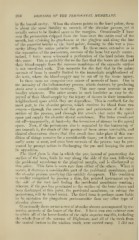Page 924 - My FlipBook
P. 924
934 DISEASES OF THE PERIDENTAL MEMBRANE. ; ;
in the buccal cavity. When the abscess points in the hard palate, there
is about the same liability to necrosis of the alveolar process, yet it
usually seems to be limited more to the margins. Occasionally I have
seen the periosteum stripped from the bone over the entire roof of the
mouth, but retaining its attachment at the gingivae and along the line
of the posterior border of the hard palate, forming in this way a pus-
cavity filling the entire palatine arch. In these cases, extensive as is
the separation of the periosteum, necrosis of the bone but rarely occurs
indeed, I have nev^er witnessed a perforation of the hard palate from
this cause. This is probably due to the fact that the bones are thin and
their blood-supply from the mucous membrane of the opposite surface
is not interfered w^ith. This accounts for the fact that in the palate
necrosis of bone is usually limited to the immediate neighborhood of
the teeth, where the blood-supply may be cut off by the tissue injury.
In these cases we recognize two causes of necrosis of bone. One is
the intensity of the inflammatory process, which destroys by producing
stasis over a considerable territory. This may cause necrosis in any
locality whatever. The other occurs in such localities as may be de-
prived of their blood-supply by the injury of tissues in their immediate
neighborhood upon which they are dependent. This is confined, for the
most part, to the alveolar process, which receives its blood from two
sources—through the vessels of the gum and periosteum of the outer
surface of the process, and through the vessels that enter the apical
space and supply the alveolar dental membrane. The latter vessels are
cut off—temporarily, at least— by the formation of abscess in the apical
space. Now, if the periosteum also is separated by the burrowing of
pus beneath it, the death of this portion of bone seems inevitable, and
clinical observation shows that this result does take place if this con-
dition of things remains for a considerable time yet it does not neces-
;
sarily occur at once, and even here necrosis of the process may be pre-
vented by prompt action in discharging the pus and keeping the parts
in apposition.
The third form is that in wdiich the pus, instead of penetrating the
surface of the bone, finds its way along the side of the root, following
the peridental membrane to the gingival margin, and is discharged at
that point. This form is more rare than either of the others. AVhen it
occurs, it destroys a considerable part of the peridental membrane, and
the alveolar process overlying this quickly disappears. This condition
is readily recognized by passing a thin, flat, pointed instrument up by
the side of the root and finding the peridental membrane wanting
whereas, if the pns has penetrated to the surfiice of the bone above and
been discharged at this point, the peridental membrane, on raising the
periosteum, will be found intact. The tliird form is perhaps more liable
to be mistaken for phagedenic pericementitis than any other type of
alveolar abscess.
Occasionally there occurs a case of alveolar abscess accompanied by ex-
tensive necrosis of the bones of the face. I have seen one extreme case
in which all of the lower border of the right superior maxilla, including
the whole floor of the antrum of Highmore, and all of the teeth from
the central incisor to the wisdom tooth, were carried away. I did not


